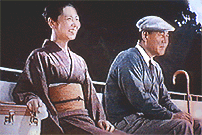Wataru Hirayama (Shin Saburi) speaks with nostalgic, muted tenderness as he recalls his arranged marriage to his wife, Kiyoko (Kinuyo Tanaka) at the wedding reception of his friend, Kawai’s (Nobuo Nakamura) elder daughter. Despite his own traditional marriage, he celebrates the freedom of young people to carve out their own destinies in the postwar, Western influenced society of contemporary Japan. Yet for his own daughter, Setsuko (Ineko Arima), Hirayama has proposed the idea of arranging a marriage with a young man from a politically influential family. His younger daughter, Hisako (Miyuki Kuwano), idealistically declares that she will only marry out of love, and Hirayama seems relieved at the unburdening of his paternal responsibility to find a suitable husband for her. At work, Hirayama is equally encumbered with the filial affairs of other parents whose relationships with their own children have been strained by their well-intentioned interference. Mikami (Chisyu Ryu), a somber, mild-mannered widower, became estranged from his daughter, Fumiko (Yoshiko Kuga), over her choice of suitors – a cabaret musician named Naganuma – and implores Hirayama to visit her on his behalf. A verbose, intrusive innkeeper from Kyoto, Sasaki (Chieko Naniwa), then pays a visit to Hirayama in order to apologize for the mis-shipment of inferior bamboo shoots intended to be sent to her less favored customers. Having found an eligible young doctor for her independent-minded daughter, Yukiko, at a Tokyo hospital, Sasaki has decided to prolong her medical treatments in an attempt to encourage their union. Nevertheless, despite Hirayama’s progressive statements on modern relationships and his sincere concern for, and outward solidarity with, the younger generation, he refuses to give his consent when a young man named Taniguchi (Keiji Sada), Setsuko’s coworker at Nitto Chemical, asks for her hand in marriage.
The first color feature film from Yasujiro Ozu, Equinox Flower is a spare, evocative, and compassionate portrait of aging, transition, and change. The title of the film refers to a red amaryllis flower that blooms near the autumnal equinox, and red imagery pervade the film: the brick train station building, the carpeting of the wedding banquet, Yukiko’s obi, the tea kettle at the Hirayama home. Similar to Ingmar Bergman’s Autumn Sonata and Andre Techine’s Ma Saison Préférée, the season serves as a reflection of Hirayama’s generation, attempting to reconcile with the profound cultural and social changes of postwar Japan. The film opens to the image of the train station and cuts to a shot of the hallway of the wedding reception. It is a reminder of Hirayama’s own transitional passage – an elegy for the quickly vanishing traditions of an irretrievable past, and a celebration of renewed hope and promise.
© Acquarello 2001. All rights reserved.
